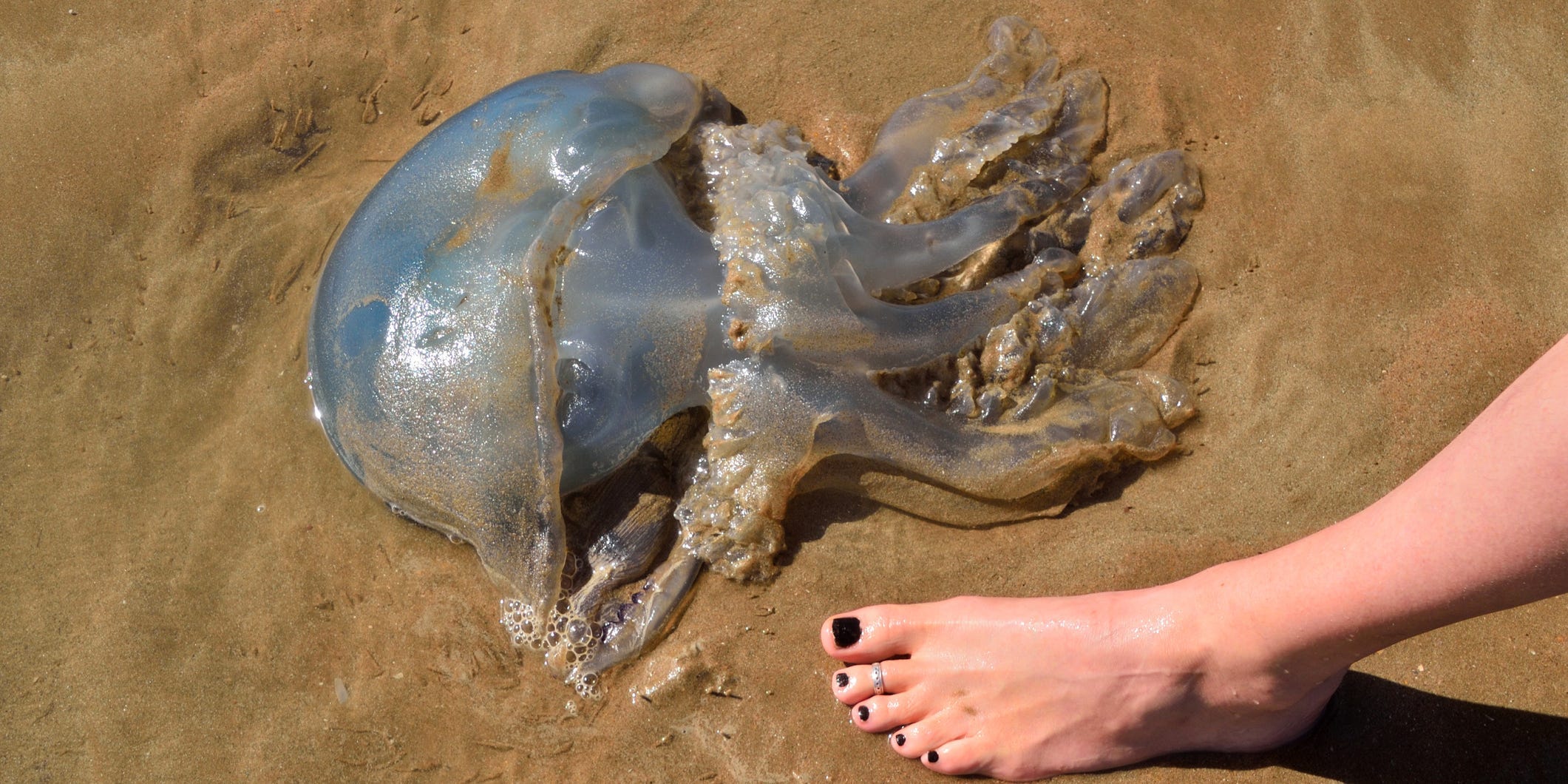
Jason Jones Travel Photography/Getty Images
- A jellyfish sting causes red or purple skin and you may see small barbs stuck in your skin.
- To remove the barbs, make a paste out of sand and seawater and scrape a credit card across your skin.
- But if you have symptoms like difficulty breathing or muscle spasms, seek medical attention ASAP.
- Visit Insider's Health Reference library for more advice.
Most jellyfish stings aren't dangerous – but some, like those from box jellyfish, can cause serious health problems or, in rare cases, death. For example, around 20 to 40 people die in the Philippines each year from box jellyfish stings.
Here's what happens when you get a jellyfish sting and how to know if you need medical attention.
What are the symptoms of a jellyfish sting?
If you are stung by a jellyfish, "the initial feeling is a burning and stinging pain at the site of contact," says Mark Conroy, MD, an emergency medicine doctor and professor at The Ohio State University Wexner Medical Center.
According to Conroy, some other common symptoms of a jellyfish sting include:
- Red or purple skin
- An outline of tentacles on your skin
- Itching
- Tenderness or throbbing pain
- Small barbs sticking out of the skin
This reaction can last anywhere from a few hours to a couple of weeks.
When to seek immediate medical attention
Certain jellyfish stings can cause more serious reactions that require a trip to the emergency room. Dangerous jellyfish tend to be larger and can deliver more potent and fast-acting venom.
Stings from these jellyfish can cause a reaction that spreads through your whole body and can be life-threatening. Signs that you have a serious reaction include:
- Weakness, fatigue, or confusion
- Stomachache, nausea, or vomiting
- Headache
- Muscle pain or spasms
- Difficulty breathing
- Irregular heartbeat
Even if you survive a serious jellyfish sting, you can still have lasting effects like damage to your heart and immune system, or permanent scars on your skin.
The severity of the sting depends on how much of the jellyfish tentacles touch your skin, so in some cases, you may be able to get help in time to prevent any permanent damage.
How to treat a jellyfish sting
If you get stung by a jellyfish, Conroy recommends a few steps to reduce the severity of the sting.
1. First, carefully leave the area to avoid any further stings. This might mean getting out of the water or moving off of the beach. If you're stung on the bottom of your foot, it's best to avoid walking on it because it may drive any microscopic barbs from the sting farther into your skin, causing more pain.
2. Remove any remaining barbs from your skin since they can contain venom that will leach into your bloodstream. To do this:
-
- Fill an empty water bottle with ocean water.
- Mix the ocean water with sand to make a paste, then apply it gently to the area of the sting.
- "Scrape a credit card across your skin to remove any remaining barbs. If you have tweezers available, those can also be helpful for removing any remaining barbs," Conroy says.
- After removing all the remaining barbs, wash the area well and dress any wounds with gauze and clean bandages.
3. If there are any open sores or blisters, you can apply an over-the-counter product like bacitracin or antibiotic ointment each time you change the dressing to prevent infection.
4. It's best to avoid swimming in the ocean for a day or two if you had a large sting or have blisters, as the salt in seawater can irritate any open wounds, says Conroy.
How to prevent a jellyfish sting
Though rare, jellyfish stings can be dangerous, so it's best to try to avoid getting them in the first place. Here are the precautions you should take:
- Avoid jellyfish on the shoreline: "Stay away from any that have washed up on shore. You can still get stung for weeks to months if they are out of the water," says Conroy. Washed up jellyfish are often clear in color and may look like a plastic bag from far away.
- Take precautions in the warmer months: You're more likely to get stung in the spring and summer months when jellyfish "bloom" in large numbers.
To avoid contact with jellyfish, "talk to the local lifeguards if they are available and ask if there are high numbers of jellyfish," Conroy advises.
Insider's takeaway
Most jellyfish stings aren't dangerous, but they can be a painful experience, causing symptoms like tenderness and swelling at the site of contact.
Taking basic first aid steps, like immediately cleaning the area with water and scraping off any barbs, can reduce the amount of venom that enters your system thereby reducing pain and other symptoms like swelling.
In rare cases, jellyfish stings can cause serious systemic symptoms like muscle spasms and difficulty breathing, and in rare cases, may be deadly. If you get any systemic symptoms like confusion, fatigue, or vomiting soon after getting a sting, go to an emergency room right away.
